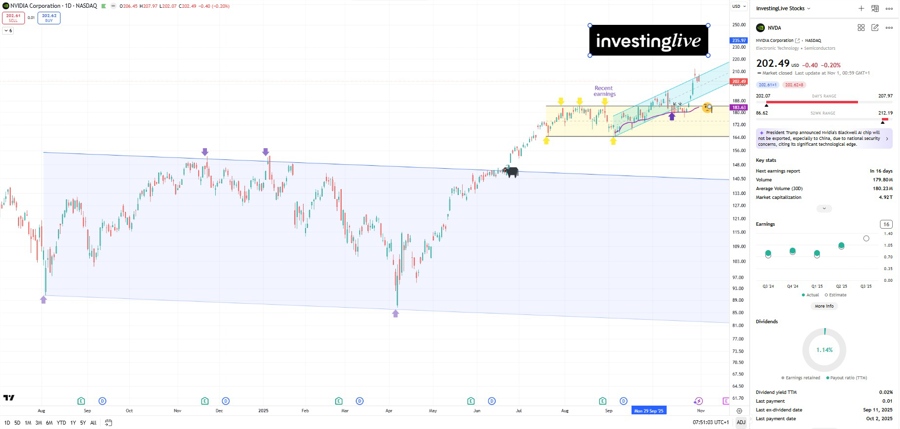Top Stories
Powell Declares AI Spending Profitable Amid Bubble Concerns

URGENT UPDATE: Federal Reserve Chair Jerome Powell has just clarified the booming landscape of artificial intelligence (AI) spending, distinguishing it from the infamous dot-com bubble. In a recent interview, Powell emphasized that today’s leading AI companies are profitable and generating substantial cash flow, directly challenging the notion of an emerging AI bubble.
Powell did not name specific firms, but his message was unmistakable. Major players like Microsoft, Alphabet, Amazon, Nvidia, and Meta are not only scaling their AI investments but also producing strong earnings. “They actually have earnings,” Powell remarked, highlighting a critical difference from the speculative startups of the 1990s.
This recent statement comes as AI technologies continue to drive significant productivity shifts across various sectors. Itai Levitan, Head of Strategy at investingLive, noted that AI is enabling individuals and companies to achieve dramatically more with fewer resources, marking what he calls “the most significant productivity boost humanity has ever seen.”
According to research, productivity gains have surged by over 10% among call-center agents using AI tools, particularly benefiting newer employees. Furthermore, consulting giant McKinsey estimates that generative AI could inject trillions of dollars into the global economy annually.
In commercial terms, OpenAI is reportedly generating around $13 billion in annual revenue, backed by approximately 30 to 40 million paying users. Meanwhile, Google’s Gemini app has amassed hundreds of millions of users globally, showcasing the widespread adoption of AI technologies.
Despite the promising landscape, some analysts caution that while AI firms are thriving, many businesses adopting these technologies are still struggling to achieve consistent profitability. Critics argue that the capital intensity of current AI spending may not be sustainable, raising questions about the long-term viability of various projects.
Powell’s observations resonate with many experts who believe that while major AI companies are indeed profitable, selective overheating could occur in less proven segments of the AI ecosystem. Investors face the challenge of differentiating between AI spending that yields immediate value and that which relies on future returns. Chipmakers and cloud providers are currently monetizing their investments, while smaller application developers may need more time to establish their economic viability.
Investors are advised to exercise caution. Powell’s comments do not suggest an immediate buy signal for AI stocks like Nvidia, which recently hovered around $200 per share—a psychological threshold that often influences trading behavior. Market dynamics around these round numbers can lead to liquidity hunts, impacting both buying and selling strategies.
As investors navigate this evolving landscape, timing remains crucial. Nvidia could see fluctuations back to around $194 or even $187, emphasizing that entry timing is vital for long-term portfolio success. The debate continues: Is there an AI bubble forming, or are these investments justified by long-term productivity gains?
We encourage readers to share their thoughts in the comments below. Your insights are essential as the discussion surrounding AI spending, profitability, and market dynamics rapidly develops. Stay tuned for the latest updates as this story unfolds.
-

 Top Stories1 week ago
Top Stories1 week agoMarc Buoniconti’s Legacy: 40 Years Later, Lives Transformed
-

 Sports3 weeks ago
Sports3 weeks agoSteve Kerr Supports Jonathan Kuminga After Ejection in Preseason Game
-

 Politics3 weeks ago
Politics3 weeks agoDallin H. Oaks Assumes Leadership of Latter-day Saints Church
-

 Science3 weeks ago
Science3 weeks agoChicago’s Viral ‘Rat Hole’ Likely Created by Squirrel, Study Reveals
-

 Business3 weeks ago
Business3 weeks agoTyler Technologies Set to Reveal Q3 2025 Earnings on October 22
-

 Lifestyle3 weeks ago
Lifestyle3 weeks agoKelsea Ballerini Launches ‘Burn the Baggage’ Candle with Ranger Station
-

 Entertainment3 weeks ago
Entertainment3 weeks agoZoe Saldana Advocates for James Cameron’s Avatar Documentary
-

 Lifestyle3 weeks ago
Lifestyle3 weeks agoDua Lipa Celebrates Passing GCSE Spanish During World Tour
-

 Health3 weeks ago
Health3 weeks agoRichard Feldman Urges Ban on Menthol in Cigarettes and Vapes
-

 Health3 weeks ago
Health3 weeks agoCommunity Unites for Seventh Annual Mental Health Awareness Walk
-

 World3 weeks ago
World3 weeks agoD’Angelo, Iconic R&B Singer, Dies at 51 After Cancer Battle
-

 Sports3 weeks ago
Sports3 weeks agoPatriots Dominate Picks as Raiders Fall in Season Opener









